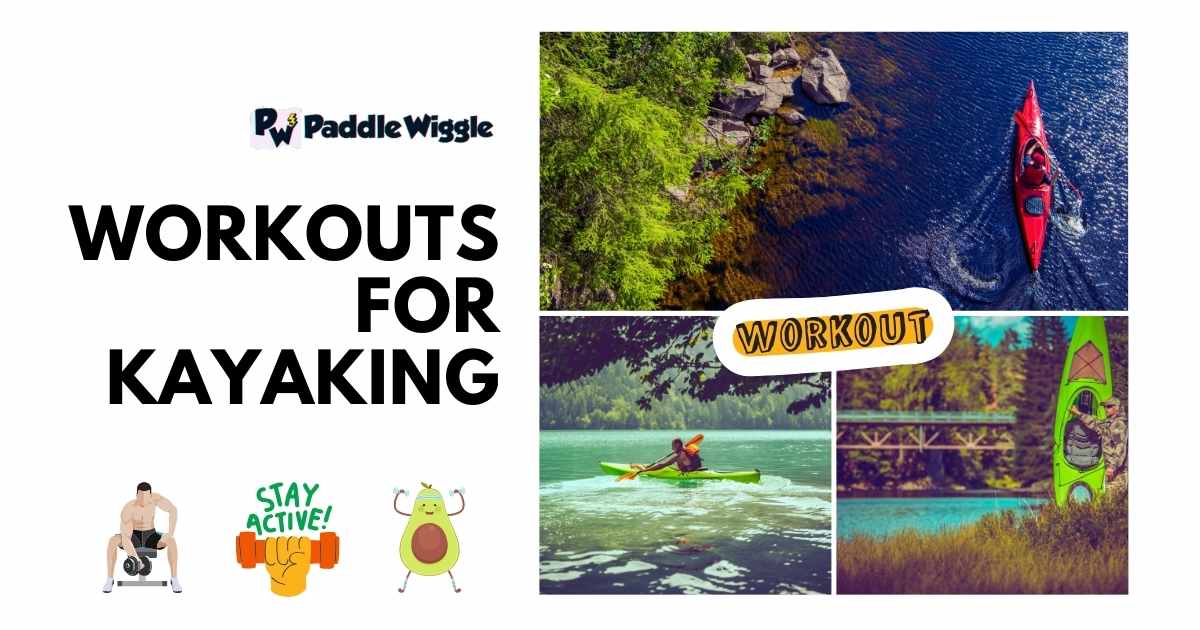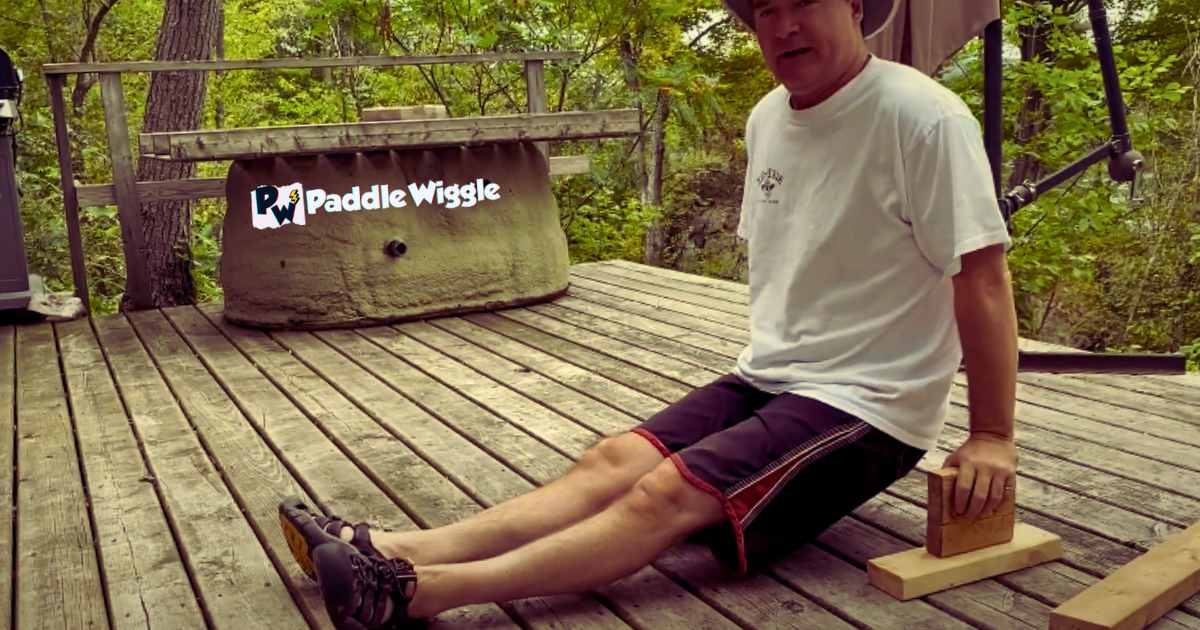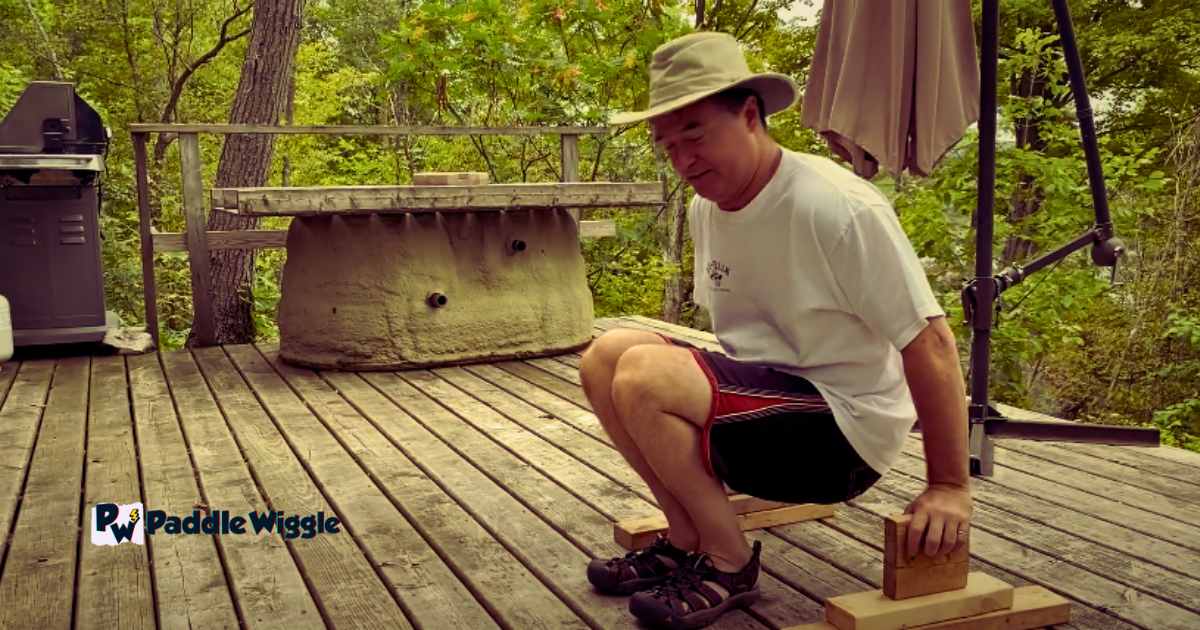Do you love kayaking and want to get better at it? This article is just for you. We’re going to show you some exercises that can help you become stronger and more powerful when you’re out on the water. It doesn’t matter if you’re a beginner or already have experience – doing these exercises can really improve how well you kayak.
To help you achieve your kayaking goals, we’ve put together a comprehensive workout plan designed specifically to boost your paddling strength and power. In the next 30 days, we’ll guide you through nine targeted workouts that will not only improve your kayaking performance but also elevate your overall fitness level.
So get ready to paddle with more energy, stamina, and confidence as we take this journey to make you a better kayaker.
Contents


The 9 Best Workouts to Improve Paddling Strength and Power
If you want to become a better kayaker, it’s essential to work on your paddling strength and power. Improve how you paddle by adding certain exercises to your training.
Here are nine effective workouts tailored for kayakers that will help you boost your strength and power on the water.
#1. Upper Body Rows


To improve your kayaking skills, it’s crucial to strengthen the muscles in your upper back and shoulders. These muscles play a significant role in generating power during paddling. One effective exercise for targeting these muscle groups is the upper body row.
Strengthen Your Back Muscles with this Essential Exercise
Upper body rows are designed to target the muscles in your upper back, shoulders, and arms. By utilizing resistance bands, dumbbells, or a rowing machine, you can engage these muscle groups and enhance their strength and endurance.
Improve Your Posture and Stability for a Better Paddling Technique


Engaging in regular upper body rows not only strengthens your back muscles but also improves your posture and stability. Proper technique is essential when kayaking to maximize efficiency and prevent injuries. By strengthening your upper body through rows, you’ll be able to maintain better form while paddling.
Engage Multiple Muscle Groups Crucial for Efficient Kayaking Strokes
When you do upper body rows, you’re not only working one muscle group, but you’re using many muscles at the same time. This exercise works your shoulders, chest, biceps, triceps, core, and even the muscles on your sides (obliques).
When you use all these different muscles at the same time, you become stronger in a balanced way, and this makes your kayaking strokes more effective. Stronger shoulder muscles mean more power during the pulling phase of each stroke.
Here are some key benefits of incorporating upper body rows into your workout routine:
- Increased muscular strength: Upper body rows help build strength in the targeted muscle groups.
- Improved endurance: If you do this exercise often, your back and shoulder muscles will get better at staying strong for a longer time.
- Enhanced pulling power: As you keep training these muscles regularly and they get stronger, you’ll be able to pull with more power.
- Reduced risk of injury: When you make these parts stronger, it keeps your shoulders steady and makes your overall posture better. This helps lower the chances of getting hurt or strained.
To perform an upper body row, follow these simple steps:
- Stand with your feet shoulder-width apart and slightly bend your knees.
- Hold a resistance band or dumbbell in each hand, palms facing inward.
- Bend forward at your hips while keeping your back straight and core engaged.
- Pull the bands or dumbbells towards your chest, squeezing your shoulder blades together.
- Slowly release back to the starting position and repeat for a set number of repetitions.
#2. Push-Ups
Push-ups are a great exercise for kayakers who want to get stronger in their upper body and have a stable core. These exercises mainly work your chest and the muscles on the back of your arms (triceps), which are important for paddling.
If you do push-ups in your workouts, you’ll be better at pushing the paddle in the water. When your chest and triceps are strong, your forward paddling will be more powerful. This helps you stay fast and in control of the water.
To perform a push-up:
- Start by getting into a plank position with your hands slightly wider than shoulder-width apart.
- Keep your body straight from head to toe, engaging your core muscles.
- Lower yourself down by bending your elbows until your chest is just above the ground.
- Push through your palms to extend your arms and return to the starting position.
Here are some key benefits of including push-ups in your kayaking workouts:
- Build Upper Body Strength: Push-ups work on many upper body muscles like the chest, triceps, shoulders, and biceps. Doing push-ups regularly makes these muscles stronger and helps you paddle with more power.
- Improve Core Stability: When you do a push-up, going up and down, you work not just your upper body but also your core muscles. This makes you more stable when paddling and helps you stay balanced on the water.
- Increase Endurance: Kayaking means you use your arms and shoulders a lot for a long time. To get better at it, you can do more push-ups, either more of them or different types like clapping push-ups or decline push-ups. This makes your arm and shoulder muscles stronger so you can keep paddling longer.
Remember these tips when doing push-ups:
- Maintain proper form throughout each repetition.
- Keep your elbows close to your sides as you lower yourself down.
- Engage your core muscles to keep your body stable.
- Breathe in as you lower yourself down and exhale as you push back up.
Adding push-ups to your kayaking workouts can make you stronger, more powerful, and able to paddle for longer on the water. So, remember to include this excellent exercise in your training regimen!
#3. Pull-Ups
Pull-ups are an excellent exercise for kayakers to include in their workout routine. These exercises mainly work on the muscles in your back, biceps, and shoulders, which are super important for making your pulls stronger when you paddle. Pull-ups make these muscles better for the part where you pull the paddle through the water.
A big plus of doing pull-ups in your training is that they make your upper body stronger. When you work on your back, arms, and shoulders, it makes these muscles stronger and able to last longer. This extra upper body strength helps you pull the paddle with more power so you can make stronger strokes and control your kayak better.
Here’s why adding pull-ups to your workout regimen can be beneficial for kayaking:
Increase Upper Body Strength
Pull-ups are an effective way to build overall upper body strength. They target multiple muscle groups simultaneously, including the back, biceps, and shoulders. As you perform pull-ups regularly, these muscles become stronger and more resilient. Getting stronger not only makes you paddle better but also stops you from getting hurt by keeping your upper body stable and supported.
Improve Pulling Power
When you’re kayaking, the strength you use to pull the paddle is super important for moving efficiently in the water. Pull-ups work on the muscles you use for this, like the ones in your back, biceps, and shoulders. If you do pull-ups often, these muscles get better at making powerful pulls with each stroke. This results in a more efficient paddle stroke and improved speed on the water.
Enhance Grip Strength
Having a strong grip is essential. Pull-ups work on big muscles, and they also make the smaller muscles in your forearms stronger, which helps you grip the paddle better. As you get better at pull-ups, you’ll find it easier to hold onto the paddle firmly. This increased grip strength allows for better control and maneuverability while kayaking.
To incorporate pull-ups into your workout routine, here are a few options:
- Traditional Pull-Ups: To do a pull-up, use a bar or something strong above you. Hold the bar with your palms facing away from you and your hands a little more than shoulder-width apart. Hang freely and then pull yourself up until your chin is above the bar. Lower yourself back down with control.
#4. Lat Pulldowns
To further enhance your paddling strength, another effective workout for kayaking is the lat pulldown. This exercise specifically targets the latissimus dorsi muscles, commonly known as the lats. Strengthening these muscles is crucial for improving the pull phase of your stroke and maximizing your paddling efficiency.
You can use a lat pulldown machine or resistance bands to work on your lat muscles, which will make your paddle strokes stronger. It’s important to use the right form and the key muscles used in paddling to move effectively in the water.
Isolate and Strengthen Key Muscles
Lat pulldowns mainly work on your latissimus dorsi muscles, which are very important for kayaking. These big back muscles are the ones that start and power the pulling action when you paddle. When you do lat pulldown exercises to make them stronger, it can make your paddling much better.
Enhance Paddling Efficiency
Doing lat pulldown exercises regularly to strengthen your lats makes your paddle stroke work better. Strong lats help you pull the paddle straighter, so you don’t waste energy on extra movements that slow you down. This means you can go faster and cover more distance with less effort.
Proper Form Matters
When you do lat pulldowns, it’s really important to do them right so they work well and you stay safe. Sit comfortably at the lat pulldown machine with your feet on the floor, or if you’re using resistance bands attached above you, you can kneel.
- Grasp the bar or handles with an overhand grip slightly wider than shoulder-width apart.
- Keep your chest lifted, shoulders relaxed, and core engaged throughout.
- Pull down smoothly until your hands reach chest level while squeezing your shoulder blades together.
- Slowly release back to the starting position, maintaining control throughout the movement.
Additional Tips and Considerations
To make the most of your lat pulldown workouts for kayaking, keep the following tips in mind:
- Gradually increase the weight or resistance as you build strength over time.
- Aim for 2-3 sets of 10-12 repetitions, resting briefly between each set.
- Incorporate lat pulldowns into your regular upper body workout routine to maintain balanced muscle development.
#5. Rotational Medicine Ball Throws
Another good exercise for improving your ability to twist and turn your body in kayaking is doing Rotational Medicine Ball Throws. It helps make your core strong and gives you the ability to steer and keep your balance when paddling.
To perform this exercise, start by standing with your feet shoulder-width apart. Hold a medicine ball in front of you with both hands. Then, rotate your torso to one side and explosively throw the ball against a wall or to a partner. Catch the ball or retrieve it from the wall and repeat the movement on the other side.
Benefits of Rotational Medicine Ball Throws
- Enhances Core Rotation: This exercise is all about building the strength you need to twist your body effectively when you’re kayaking. When you make these muscles stronger, it helps you paddle with more power and control.
- Improves Steering and Balance: When you’re kayaking, it’s important to steer accurately and stay balanced, especially in tricky water situations. If you add rotational medicine ball throws to your exercise routine, it can help you become better at staying stable and in control as you paddle through different types of water.
- Promotes Core Stability: Kayakers need a strong core to stay steady while paddling and keep good posture. Rotational medicine ball throws work your core muscles, including your sides and abs, to make your core strong and stable.
- Explosive Movements: Kayaking strokes require explosive movements that generate power efficiently. This exercise helps develop explosive strength in your upper body, allowing you to execute powerful paddle strokes with ease.
- Improves Coordination: To be good at kayaking, you need to coordinate your upper body, core, and lower body movements. Rotational medicine ball throws help these muscles work together better, making you more coordinated when you paddle.
Adding rotational medicine ball throws to your kayaking workouts can really make you better on the water. It strengthens your core, makes your twisting power stronger, and helps you move more explosively. This means you’ll have more control, be able to steer better, and stay more stable when you paddle.
So grab a medicine ball, find a wall or a partner, and start incorporating this exercise into your training routine. Get ready to take your kayaking skills to the next level!
#6. Deadlifts
Deadlifts are an awesome exercise for kayakers like you! They target important muscles such as the lower back, glutes, and hamstrings. These muscles play a crucial role in providing stability and power while paddling.
When you’re out on the water, having a strong lower back is essential for maintaining good posture and preventing injuries. Deadlifts help strengthen this area by working the muscles along your spine. They also work your butt muscles (glutes) and the muscles at the back of your thighs (hamstrings). These muscles are important for making strong paddle strokes.
To get the good stuff from doing deadlifts, think about adding them to your weightlifting or strength training plan. You can do deadlifts with a barbell or dumbbell, depending on what you’ve got. Here’s how to do it:
- Stand with your feet shoulder-width apart, toes pointing slightly outward.
- Bend down and grasp the barbell (or dumbbells) with an overhand grip, hands just outside your legs.
- Keep your back straight and core engaged as you lift the weight by extending your hips and knees.
- As you stand up straight, focus on squeezing your glutes at the top of the movement.
- Slowly lower the weight back down to the starting position while maintaining control.
Remember to start with lighter weights if you’re new to deadlifting and gradually increase as you become more comfortable with proper form.
The benefits of incorporating deadlifts into your workout routine extend beyond kayaking performance:
- Strengthening key muscle groups: Deadlifts target not only the lower back but also other important muscles like the glutes, hamstrings, and quadriceps. By strengthening these muscle groups, you’ll improve overall stability in your kayak.
- Generating powerful paddle strokes: Deadlifts, which involve quick, strong movements, build up strength in your lower body. This helps you make powerful paddle strokes. Having stronger hips and hip flexor muscles also makes your movements in the water smoother and more powerful.
- Improving posture and preventing injuries: Deadlifts engage multiple muscle fibers, including those in your core and back. This helps improve your posture both on and off the water, reducing the risk of injuries caused by poor alignment or weak muscles.
Incorporating deadlifts into your kayaking workout routine can be a game-changer. Not only will you strengthen key muscle groups for stability and power, but you’ll also improve your overall posture and reduce the risk of injuries.
#7. Russian Twists
Sit on the floor with your knees bent and feet off the ground. Hold a weight or medicine ball and twist your torso from side to side. This exercise improves core strength and rotational power.
Russian twists are an excellent addition to any kayaker’s workout routine. These exercises focus on the side muscles (obliques) and the core muscles, which are really important for turning and staying steady in a kayak. When you use these muscles, it can make you a lot more stable and balanced on the water.
Russian twists are good because they make your twisting strength better, which you need for good paddle strokes. When you twist your body from side to side, it’s like practicing the motion of paddling, which helps you get better at twisting for efficient strokes. This increased rotational strength translates into more powerful and controlled movements when kayaking.
Russian twists make your core muscles stronger, which is important for keeping a good posture while kayaking. A strong core helps your back and lets you paddle smoothly without getting tired or messing up your technique.
Here are some key points about incorporating Russian twists into your kayaking workouts:
- Engage core muscles: When you do Russian twists, you work out more than just your obliques. You also use your six-pack muscles and deep abdominal muscles. Strengthening these muscles will provide a solid foundation for stability in your kayak.
- Improve balance: By targeting your obliques, Russian twists help improve lateral stability in your kayak. This is especially important when navigating rough waters or dealing with unpredictable currents.
- Enhance performance: If your core is strong, you can paddle faster and use your energy better when you’re on the water.
- Prevent injuries: Having a strong core helps protect against common kayaking injuries, such as lower back pain, by providing better support and stability to your spine.
To incorporate Russian twists into your kayaking workout routine, you can follow these simple steps:
- Sit on the floor with your knees bent and feet off the ground.
- Hold a weight or medicine ball in front of your chest.
- Engage your core muscles and lean back slightly while keeping your back straight.
- Twist your torso to one side, bringing the weight or medicine ball close to the floor.
- Return to the center and then twist to the other side, repeating the motion.
#8. Box Jumps
Box jumps, which are like jumping up on a box, are a great exercise for kayakers who want to make their leg muscles super strong and be able to go fast in their kayak and do strong paddle strokes. It’s all about building strong leg muscles for quick moves in the water.
When you do box jumps in your training, you can make your leg muscles super strong. This will help you speed up fast and do powerful paddle strokes when you need to.
Here’s why box jumps are beneficial for kayaking:
Increase Lower Body Power and Explosiveness
Box jumps are a kind of exercise where you jump onto a high platform from standing still. This quick and strong move uses your leg muscles, like your thighs and calves. When you do box jumps often, your leg muscles get stronger and more powerful.
Improve Leg Strength for Powerful Strokes
In kayaking, it’s important to push the paddle hard with each stroke to move efficiently. Box jumps make your leg muscles stronger, and these muscles are important for paddling. When you do box jumps, it’s like practicing the strong leg movement needed for paddling. This exercise helps you get the strength to do powerful paddle strokes.
Enhance Agility and Coordination
To be good at kayaking, you have to be quick and work well with your body on the water. Jumping onto a platform in a certain way also needs good footwork and teamwork. If you practice jumping on the platform often, you’ll get better at being quick and working well with your body. This will help you move faster while kayaking.
Modifications for Different Fitness Levels
You can change how you do box jumps to match your fitness level or take care of your knees. If jumping onto a tall box hurts your knees, begin with a shorter platform or do step-ups instead. Gradually increase the height of the box as your leg strength improves.
Here are some additional tips for performing box jumps safely:
- Warm up adequately before attempting box jumps to prevent injuries.
- Start with a lower box height and gradually increase it as you build strength and confidence.
- When you jump, make sure to land softly, bend your knees to reduce the impact, and then quickly jump back onto the box.
- When you’re doing the exercise, make sure to use the right posture. Keep your tummy muscles tight and your back straight.
Incorporating box jumps into your workout routine can significantly benefit your kayaking performance. Remember to consult with a fitness professional or coach if you have any concerns or specific training goals.
#9. Kayak Ergometer Training
If you want to get better at kayaking and have more stamina, you can use a cool method called kayak ergometer training. It’s like using a special machine that imitates the way you paddle a kayak, but you do it on dry land. It’s like paddling without actually being in the water!
Kayak ergometer training is a great way to work on the muscles you use for kayaking and make yourself better at it. Here’s why it can be beneficial:
Utilize a specialized training tool
A kayak ergometer is a special tool made just for kayakers. It lets you practice paddling like you’re on the water, but you stay on dry land. This means you can practice your strokes and perfect your form even when you’re away from the water.
Improve endurance, technique, and performance
If you do kayak ergometer training often, it can really help you get better at kayaking. It will make your muscles stronger, especially in your core, arms, shoulders, and back – which are super important for paddling.
Train in a controlled environment
A good thing about the kayak ergometer is that you can work on specific muscle groups in a safe and controlled way. You can change how hard it is based on how fit you are and make it tougher as you get better. This allows for gradual muscle development without risking injury or overexertion.
Specific drills for enhanced performance
The kayak ergometer has different exercises that copy things you might do when you’re kayaking for real. Like, you can do interval training to practice going fast and handling tough currents. Endurance-focused workouts can prepare you for long-distance paddling adventures.
Build strength and power
Kayak ergometers are great for making your upper body, like your arms, shoulders, and core, really strong for kayaking. If you use the ergometer regularly, your paddling will be more efficient and powerful.
Enhance muscle memory
Repetitive motion is key to developing muscle memory—a crucial aspect of kayaking. Regular kayak ergometer training helps reinforce proper stroke technique and body positioning. This muscle memory will carry over into your actual kayaking sessions, allowing you to paddle more efficiently and effectively.
A 30-Day Routine For Quickly Improving Paddling Strength
To enhance your paddling strength and power in just 30 days, a focused and consistent training routine is necessary. Here’s a four-week plan designed to help you achieve noticeable gains in your kayaking performance.
| Day | Workout | Sample Exercises | Session Duration | On-Water Training |
|---|---|---|---|---|
| Day 1 | Upper Body Rows and Push-Ups | Upper Body Rows: 3 sets of 10 reps, Push-Ups: 3 sets of 12 reps | 30 minutes | – |
| Day 2 | Pull-ups and Lat Pulldowns | Pull-Ups: 3 sets of 8 reps, Lat Pulldowns: 3 sets of 10 reps | 30 minutes | – |
| Day 3 | Rotational Medicine Ball Throws | Rotational Medicine Ball Throws: 3 sets of 8 reps (each side) | 30 minutes | – |
| Day 4 | Russian Twists and Box Jumps | Russian Twists: 3 sets of 12 reps (each side), Box Jumps: 3 sets of 10 jumps | 30 minutes | – |
| Day 5 | Kayak Ergometer Training | Kayak Ergometer: 20 minutes | 20 minutes | – |
| Day 6 | Rest and Recovery | – | – | – |
| Day 7 | Cardio and Endurance | 45 minutes of moderate-intensity cardio (running, cycling, or swimming) | 45 minutes | – |
| Day 8 | Upper Body Rows and Push-Ups | Upper Body Rows: 3 sets of 12 reps, Push-Ups: 4 sets of 12 reps | 45 minutes | – |
| Day 9 | Pull-ups and Lat Pulldowns | Pull-Ups: 3 sets of 10 reps, Lat Pulldowns: 3 sets of 12 reps | 45 minutes | – |
| Day 10 | Rotational Medicine Ball Throws | Rotational Medicine Ball Throws: 3 sets of 10 reps (each side) | 45 minutes | – |
| Day 11 | Russian Twists and Box Jumps | Russian Twists: 3 sets of 15 reps (each side), Box Jumps: 3 sets of 12 jumps | 45 minutes | – |
| Day 12 | Kayak Ergometer Training | Kayak Ergometer: 25 minutes | 25 minutes | – |
| Day 13 | Rest and Recovery | – | – | – |
| Day 14 | Cardio and Endurance | 60 minutes of moderate-intensity cardio | 60 minutes | – |
| Day 15 | Upper Body Rows and Push-Ups | Upper Body Rows: 3 sets of 12 reps, Push-Ups: 4 sets of 12 reps | 60 minutes | – |
| Day 16 | Pull-ups and Lat Pulldowns | Pull-Ups: 3 sets of 10 reps, Lat Pulldowns: 3 sets of 12 reps | 60 minutes | 15 minutes of Ergometer |
| Day 17 | Rotational Medicine Ball Throws | Rotational Medicine Ball Throws: 3 sets of 10 reps (each side) | 60 minutes | – |
| Day 18 | Russian Twists and Box Jumps | Russian Twists: 3 sets of 15 reps (each side), Box Jumps: 3 sets of 12 jumps | 60 minutes | – |
| Day 19 | Kayak Ergometer Training | Kayak Ergometer: 30 minutes | 30 minutes | – |
| Day 20 | Rest and Recovery | – | – | – |
| Day 21 | Cardio and Endurance | 60 minutes of moderate-intensity cardio | 60 minutes | – |
| Day 22 | Upper Body Rows and Push-Ups | Upper Body Rows: 3 sets of 12 reps, Push-Ups: 4 sets of 12 reps | 75 minutes | 20 minutes of Ergometer |
| Day 23 | Pull-Ups and Lat Pulldowns | Pull-Ups: 3 sets of 12 reps, Lat Pulldowns: 3 sets of 15 reps | 75 minutes | 20 minutes of Ergometer |
| Day 24 | Rotational Medicine Ball Throws | Rotational Medicine Ball Throws: 3 sets of 12 reps (each side) | 75 minutes | – |
| Day 25 | Russian Twists and Box Jumps | Russian Twists: 3 sets of 15 reps (each side), Box Jumps: 3 sets of 15 jumps | 75 minutes | – |
| Day 26 | Kayak Ergometer Training | Kayak Ergometer: 35 minutes | 35 minutes | – |
| Day 27 | Rest and Recovery | – | – | – |
| Day 28 | Cardio and Endurance | 60 minutes of moderate-intensity cardio | 60 minutes | – |
| Day 29 | Active Recovery | Gentle yoga, stretching, or light swimming | 30 minutes | – |
| Day 30 | Final Assessment | Evaluate paddling speed and endurance progress | 30 minutes | – |
Learn More
Can I do these workouts For Kayaking at home?
Yes! Many of these exercises require minimal equipment and can be done in the comfort of your own home. Invest in a set of dumbbells, resistance bands, and a stability ball to maximize your at-home workout options.
Will these exercises help me lose weight?
These exercises mainly help make you better at paddling with more strength and power. But when you eat well and stay active in general, they can also help you lose weight. Remember that consistency is key.
Final Words
To make your training even better, do your workouts on a set schedule and make them harder as you get better. You can also try different exercises that work different muscles and make you better at sports in general. Make sure to eat healthy foods and drink enough water while you’re training too.


